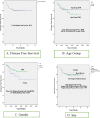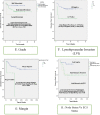Predictors of Occult Neck Metastasis and Extra Capsular Spread in Early Oral Cancers
- PMID: 36452804
- PMCID: PMC9702186
- DOI: 10.1007/s12070-020-02020-7
Predictors of Occult Neck Metastasis and Extra Capsular Spread in Early Oral Cancers
Abstract
To investigate the incidence of occult neck metastasis and to determine the prognostic factors related to the occurrence of the cervical lymph nodal metastasis and extra capsular extension (ECE) in early oral cavity cancer patients. A retrospective review performed on 100 patients with node negative squamous cell carcinoma of oral cavity who underwent primary treatment between Jan 2015 and Dec 2018. Incidence of occult neck metastasis after the elective neck dissection in our study was 35%. Independent correlates of positive occult neck metastasis were lymphovascular Invasion (P-0.000)[CI 0.004-0.326] and depth of invasion(P-0.009)[CI 0.509-13.428] on univariate analysis and statistically significant factors associated with the incidence of the extracapsular extension were age(P-0.044), lymphovascular invasion(P-0.018)[CI 0.004-0.603] and lymph node ratio(P-0.000)[CI 4.570-158.45] on univariate analysis. Lymphovascular invasion and depth of invasion correlated significantly with occurrence of neck metastasis. Age and LVI were the prognostic factors for extra capsular spread.
Keywords: Early oral cancers; Extra capsular spread; Lymphnodal metastasis; Occult neck metastasis.
© Association of Otolaryngologists of India 2020.
Conflict of interest statement
Conflict of interestNo disclosure or conflict of interest for the author and the co-authors.
Figures
Similar articles
-
Development and Validation of Machine Learning Models for Predicting Occult Nodal Metastasis in Early-Stage Oral Cavity Squamous Cell Carcinoma.JAMA Netw Open. 2022 Apr 1;5(4):e227226. doi: 10.1001/jamanetworkopen.2022.7226. JAMA Netw Open. 2022. PMID: 35416990 Free PMC article.
-
Is the Depth of Invasion a Marker for Elective Neck Dissection in Early Oral Squamous Cell Carcinoma?Front Oncol. 2021 Mar 12;11:628320. doi: 10.3389/fonc.2021.628320. eCollection 2021. Front Oncol. 2021. PMID: 33777774 Free PMC article.
-
Depth of Invasion as a Predictor of Cervical Nodal Metastasis of Oral Tongue Squamous Cell Carcinoma: Findings From a Tertiary Care Center in Pakistan.Cureus. 2021 Oct 22;13(10):e18976. doi: 10.7759/cureus.18976. eCollection 2021 Oct. Cureus. 2021. PMID: 34820231 Free PMC article.
-
Elective neck dissection in oral carcinoma: a critical review of the evidence.Acta Otorhinolaryngol Ital. 2007 Jun;27(3):113-7. Acta Otorhinolaryngol Ital. 2007. PMID: 17883186 Free PMC article. Review.
-
Depth of invasion as a predictive factor for cervical lymph node metastasis in tongue carcinoma.Head Neck. 1997 May;19(3):205-10. doi: 10.1002/(sici)1097-0347(199705)19:3<205::aid-hed7>3.0.co;2-6. Head Neck. 1997. PMID: 9142520 Review.
Cited by
-
Role of Imaging and Histopathology for Predicting Neck Node Involvement in Recurrent/Second Primary Squamous Cell Carcinoma (pN-ROC Study).J Maxillofac Oral Surg. 2024 Aug;23(4):837-842. doi: 10.1007/s12663-024-02272-8. Epub 2024 Jul 9. J Maxillofac Oral Surg. 2024. PMID: 39118935 Free PMC article.
-
Oral squamous cell carcinoma - do we always need elective neck dissection? evaluation of clinicopathological factors of greatest prognostic significance: a cross-sectional observational study.Front Oncol. 2023 Sep 14;13:1203439. doi: 10.3389/fonc.2023.1203439. eCollection 2023. Front Oncol. 2023. PMID: 37781178 Free PMC article. Review.
-
Prognostic factors of oral squamous cell carcinoma: the importance of recurrence and pTNM stage.Maxillofac Plast Reconstr Surg. 2024 Mar 4;46(1):8. doi: 10.1186/s40902-024-00410-3. Maxillofac Plast Reconstr Surg. 2024. PMID: 38433140 Free PMC article.
References
-
- Arora N, Singh J, Davessar JL, et al. Evaluating cervical lymph node metastasis: a comparative study of CT scan and physical examination with cytological results. Clinical research. J Head Neck Physicians Surg. 2016;27(1):21–72.
LinkOut - more resources
Full Text Sources
Research Materials


